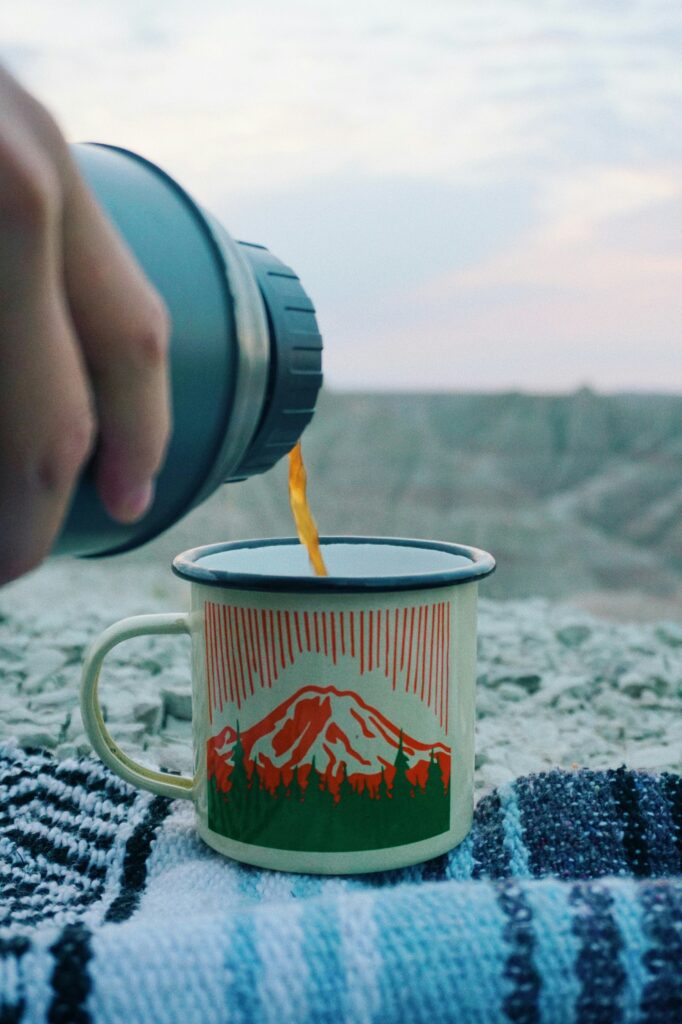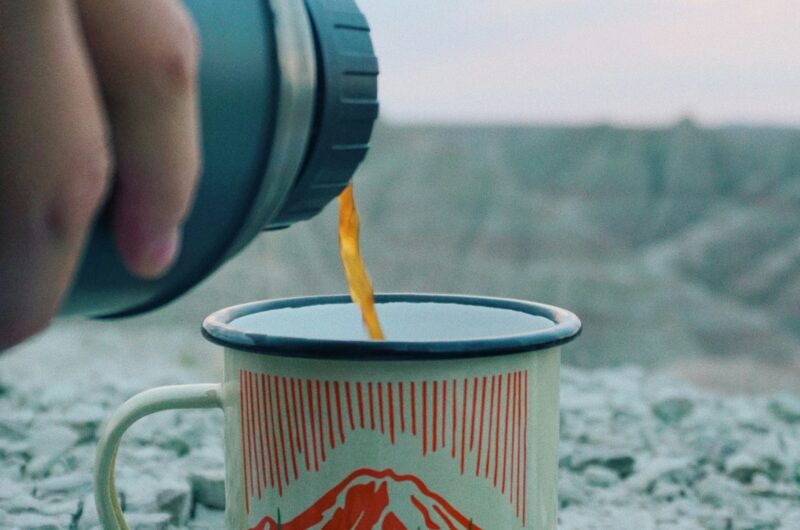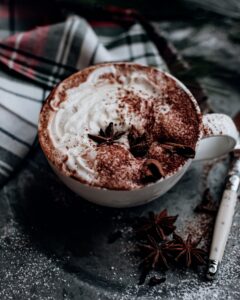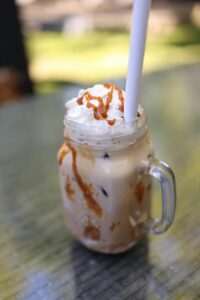Imagine waking up under the open sky, the scent of pine in the air, and a pot of coffee bubbling over a crackling fire. No gadgets. No buttons. Just fire, water, and grit.
That’s cowboy coffee. Raw, old-school, and shockingly good when done right.
In this guide, we’re breaking down what it is, how to make it, why it still holds up, and how to avoid ending up with a cup full of sludge. Let’s get brewing!
What Is Cowboy Coffee?
Cowboy coffee is the original no-fuss brew—just ground coffee, hot water, and a little grit (both literal and figurative).
It’s made by tossing coarsely ground coffee straight into boiling water, letting it steep, then pouring it slowly to dodge the grounds. No filters, no machines, but just a pot over a flame.
This rugged method dates back to the American frontier days when cowboys, ranchers, and pioneers didn’t have French presses or espresso machines at their disposal.
Out on the open range, they made do with what they had: a fire, a kettle, and a strong desire to stay awake through cattle drives.
The result was bold, smoky coffee with a taste as strong as the folks who drank it. Fast forward to today, and cowboy coffee is making a quiet comeback. Campers love it for its simplicity.
Hikers swear by it for backcountry mornings. Even minimalist coffee lovers at home are embracing it as a way to reconnect with the roots of brewing.
It’s gritty, nostalgic, and surprisingly satisfying, especially when made with care.
Pros and Cons of Cowboy Coffee
Pros
- No gear required: Just coffee, water, and heat. No filters, presses, or plugs.
- Bold, strong flavor: It’s unfiltered and full-bodied, perfect for folks who like their coffee to kick.
- Perfect for camping or off-grid living: Great for outdoor adventures, power outages, or minimalist mornings.
- Easy to clean up: No filter waste or complicated parts—just rinse the pot when you’re done.
Cons
- Can get gritty: Grounds in the cup are common if you don’t let them settle properly.
- Easily turns bitter: Boiling the coffee (instead of steeping it) extracts harsh flavors fast.
- No temperature control: You’re relying on timing and experience, so there’s no thermometer or fancy dial to help.
What You’ll Need (Minimal Equipment List)
Cowboy coffee doesn’t need a kitchen full of gadgets. In fact, that’s the whole point. It’s rustic, simple, and made with what you’ve got.
But to brew a decent cup without ending up with a mouthful of mud, here’s what you’ll want on hand:
A Small Pot or Kettle
This is your coffee cauldron. It can be an old-school camping kettle, a beat-up saucepan, or even a tin can in a pinch. Ideally, choose something metal so it handles heat well and won’t crack or melt.
A pour spout helps, but it’s not a dealbreaker. What matters most is that it can hold water and sit over a flame without complaining.
Fresh Coarse-Ground Coffee
Don’t grab the powdery pre-ground stuff meant for drip machines—it’ll turn your cup into sludge city. Instead, go for a medium-coarse grind, similar to what you’d use for a French press.
This makes it easier for the grounds to settle and keeps your teeth free from unwanted crunch. Freshly ground beans are best, but if you’re packing light, pre-grind them at home before your trip.
Clean Water (Filtered If Possible)
Your coffee is only as good as your water. If you’re brewing in the wild, filter or boil your water first to remove any unwanted extras (like pond funk or floating surprises).
At home, just use filtered tap water if you’ve got it. For two cups, you’ll need around 2 cups (480 ml) of water.
Heat Source: Fire, Stove, or Coals
This is where cowboy coffee gets its rugged rep. Campfire is the classic, but you can also use a gas stove, grill, or even hot coals.
Basically, anything that gets your water hot enough to boil will do the trick. No temperature control? No problem. You’ll be relying on timing and instincts anyway—just like the cowboys did!
Optional Tools: Spoon, Mug, Eggshells
- Spoon – Stirring helps distribute the grounds and extract flavor.
- Mug – Unless you want to drink straight from the pot (you beast).
- Eggshells – Sounds weird, but old-school brewers swear by it. Crushed eggshells help settle the grounds and reduce bitterness thanks to their alkaline nature. Totally optional, but worth a try if you’re feeling adventurous—or just like a bit of cowboy lore in your cup.
Cowboy Coffee Recipe (Step-by-Step)
This no-fuss cowboy coffee recipe is perfect whether you’re by a campfire or just craving a rugged brew at home.
It’s strong, simple, and deeply satisfying when done right.
Ingredients:
- 3 tablespoons coarsely ground coffee
- 2 cups water
- Pinch of salt (optional, helps cut bitterness)
- Crushed eggshells (optional, helps settle grounds and smooth flavor)
Directions:
- Bring water to a near boil
Heat 2 cups of water over a fire, stove, or grill until it’s just about to boil. - Remove from heat and let sit 30 seconds
This short wait helps cool the water slightly and prevents scalding the grounds (which can cause bitterness). - Add coffee grounds
Toss in the 3 tablespoons of coarse coffee directly into the hot water. Add your crushed eggshells now if using. - Stir well
Give it a good swirl to mix everything together. This helps with extraction and flavor. - Steep, don’t boil
Either return the pot to very low heat or let it steep off the heat entirely for 4–5 minutes. Avoid boiling again—bitterness is not your friend. - Settle the grounds
Once steeped, gently tap the pot or splash in a small amount of cold water. This coaxes the grounds to the bottom of the pot. - Pour slowly into mugs
Go slow and steady. Ladle gently or tilt the pot to keep most of the grounds where they belong—at the bottom.
Flavor Profile & How It Compares
Taste: Strong, Bold, and a Bit Smoky
Cowboy coffee doesn’t tiptoe around your taste buds—it kicks the door down. The flavor is strong, earthy, and often slightly smoky, especially if brewed over an open flame.
It’s got body, depth, and a bit of grit in both flavor and texture (if you’re not careful with the pour). There’s no filter here to tone things down, so what you taste is the raw essence of the beans.
Love a punchy cup that wakes you up before the caffeine even kicks in? This is your kind of brew.
Compared to the French Press
If you’ve had French press, you’re in familiar territory. Both methods let oils and fine particles stay in the cup, giving you a fuller-bodied coffee.
But cowboy coffee skips the filter altogether, so it’s a little rougher around the edges. It might have more sediment if you don’t let the grounds settle well.
French press is a bit more refined; cowboy coffee is the rugged cousin who shows up with muddy boots and great stories.
Compared to Drip Coffee
Drip coffee is filtered, clean, and usually milder. It’s consistent. It’s predictable. It’s… fine. But cowboy coffee laughs at predictability. It’s stronger, less filtered (literally and figuratively), and way more rustic.
You won’t get the same clean cup as a drip machine, but you’ll get flavor with a backbone. If drip is the polite handshake, cowboy coffee is a firm grip and a “howdy.”
Best Suited For…
This style is tailor-made for black coffee drinkers—especially those who love intensity without fuss. It’s also great for campers and outdoor lovers who don’t want to lug around gear.
And if you’re into bold, adventurous flavors and don’t mind a little edge, cowboy coffee might just be your new favorite morning ritual.
Tips for Better Cowboy Coffee
Cowboy coffee might be simple, but it’s also easy to mess up if you’re not paying attention. A few small tweaks can make the difference between a smooth, bold cup and a bitter, sludgy disaster.
Here’s how to get it right every time.
Don’t Boil After Adding Grounds
This is the golden rule. Once your water is hot, take it off the heat before adding coffee. If you boil it after the grounds go in, you’ll end up with a brew that tastes like burnt tires.
Steeping, not boiling, is what draws out flavor without dragging bitterness along for the ride.
Use Medium-Coarse Grind to Reduce Sludge
Finer grinds = muddy coffee. Go for a medium-coarse grind—roughly the texture of sea salt or breadcrumbs. This helps the grounds settle at the bottom and keeps your final pour cleaner.
If you grind your own beans, dial it back a few notches from what you’d use for drip coffee.
Let the Grounds Steep Fully Before Serving
Patience pays off. Give the coffee 4–5 full minutes to steep after you stir it in. This not only extracts flavor properly, but also gives the grounds time to sink.
Rushing it will leave you with a weak brew and a mouthful of floaters.
Pour Slowly or Strain Through Cloth
Don’t just dump the pot into your mug—pour with care. Tip it slowly so you leave the settled grounds at the bottom.
If you’re picky or serving guests, use a bandana, clean sock (seriously), or cheesecloth as a makeshift filter for an extra-smooth pour.
Use the Cold Water Trick to Settle Grounds
This one’s old-school genius. After steeping, add a quick splash of cold water to the pot. It works like a charm to force any floating grounds down to the bottom.
Just a tablespoon or two is all it takes, and your cup will be noticeably clearer.
When & Why to Brew Cowboy-Style
Camping or Off-Grid Mornings
This is cowboy coffee’s natural habitat. No electricity? No problem. All you need is a fire, a pot, and some coarse grounds.
Whether you’re deep in the woods or just backyard glamping, cowboy coffee brings the perfect rustic start to your morning.
It’s warm, it’s bold, and it just tastes better when you’re surrounded by pine trees and fresh air.
Emergency Power Outages
When the power’s out and your Keurig’s just a dead hunk of plastic, cowboy coffee steps up. You can brew it on a gas stove, grill, or even a candle-powered emergency burner if you’re desperate.
It’s fast, dependable, and doesn’t care if your Wi-Fi is down. When the lights go out, this brew keeps the lights on in your brain.
Gear-Free Minimalist Mornings
Some mornings, the idea of fussing with buttons, timers, or pour-over spirals just feels like too much. Cowboy coffee is the “throw it all in and go” method. No filters. No scales.
Just you, the pot, and a cup of ambition. It’s ideal for lazy Sundays or slow mornings when simplicity is the vibe.
A Nostalgic Brewing Experience
Maybe it reminds you of your grandpa’s old tin kettle. Maybe you’re chasing that old-world charm. Either way, brewing cowboy-style is a throwback that is raw, rugged, and strangely satisfying.
It’s coffee with character. Coffee that makes you feel like you’ve earned it, even if all you did was roll out of bed.
Final Words
Cowboy coffee proves that simple doesn’t mean inferior. It’s bold, bracing, and has stood the test of time.
Whether you’re roughing it outdoors or just want to ditch your drip machine for a day, this old-school method has your back. Give it a try, and you might just fall in love with the grit and glory!
FAQs
Does cowboy coffee have more caffeine?
It can. Cowboy coffee is usually brewed strong, so you might get more caffeine per cup compared to standard drip. That said, it really depends on your beans and how long you let it steep.
Can I use instant coffee for cowboy coffee?
Technically? Sure. But let’s be honest, that’s missing the point. Cowboy coffee is all about brewing real, fresh grounds the old-fashioned way.
Instant coffee skips the ritual, the flavor, and the whole cowboy spirit.
Do I need to use eggshells?
Nope, not required. But they’re a cool trick. Crushed eggshells can help settle the grounds and take the edge off any bitterness. Think of them as the cowboys’ built-in water filter and flavor balancer.
Will I get coffee grounds in my cup?
Maybe a few floaters, especially if you pour too fast. But if you let the grounds settle properly and pour slowly or use a cloth to strain, you’ll avoid most of the grit.
Just don’t chug the last sip from the pot unless you like surprises.
Can I use a camping kettle instead of a pot?
Absolutely. Any metal container will do the job as long as it can handle heat and hold water. Kettle, saucepan, or even a tin can—if it boils water, it brews cowboy coffee.
How to Make Cowboy Coffee — The No-Gear, Campfire Classic
Course: Brewing GuidesDifficulty: Easy2
cups2
minutes5
minutes7
minutesThis no-fuss cowboy coffee recipe is perfect whether you’re by a campfire or just craving a rugged brew at home. It’s strong, simple, and deeply satisfying when done right.
Ingredients
3 tablespoons coarsely ground coffee
2 cups water
Pinch of salt (optional)
Crushed eggshells (optional, to reduce bitterness & help grounds settle)
Directions
- Bring water to a near boil over fire or a heat source.
- Remove from heat, let sit 30 seconds (reduces bitterness).
- Add ground coffee directly to hot water.
- Stir and return to very low heat or keep off heat to steep.
- Let steep for 4–5 minutes (don’t boil again).
- Tap the pot or add a cold splash of water to settle grounds.
- Slowly pour into mugs or ladle gently to avoid grounds.
Notes
- Use fresher grounds for better flavor.
- A cheesecloth or bandana can be used as a makeshift filter.
- Try the “eggshell trick” to reduce bitterness and help grounds sink.




